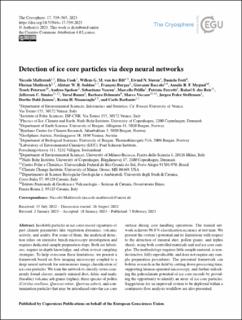| dc.contributor.author | Maffezzoli, Niccolò | |
| dc.contributor.author | Cook, Eliza | |
| dc.contributor.author | van der Bilt, Willem Godert Maria | |
| dc.contributor.author | Støren, Eivind | |
| dc.contributor.author | Festi, Daniela | |
| dc.contributor.author | Muthreich, Florian | |
| dc.contributor.author | Seddon, Alistair William Robin | |
| dc.contributor.author | Burgay, François | |
| dc.contributor.author | Baccolo, Giovanni | |
| dc.contributor.author | Mygind, Amalie | |
| dc.contributor.author | Petersen, Troels | |
| dc.contributor.author | Spolaor, Andrea | |
| dc.contributor.author | Vascon, Alessio | |
| dc.contributor.author | Pelillo, Marcello | |
| dc.contributor.author | Ferretti, Patrizia | |
| dc.contributor.author | dos Reis, Rafael S. | |
| dc.contributor.author | Simões, Jefferson | |
| dc.contributor.author | Ronen, Yuval | |
| dc.contributor.author | Delmonte, Barbara | |
| dc.contributor.author | Viccaro, Marco | |
| dc.contributor.author | Steffensen, Jørgen Peder | |
| dc.contributor.author | Dahl-Jensen, Dorthe | |
| dc.contributor.author | Nisancioglu, Kerim Hestnes | |
| dc.contributor.author | Brabante, Carlo | |
| dc.date.accessioned | 2023-05-12T11:40:13Z | |
| dc.date.available | 2023-05-12T11:40:13Z | |
| dc.date.created | 2023-05-11T18:06:05Z | |
| dc.date.issued | 2023 | |
| dc.identifier.issn | 1994-0416 | |
| dc.identifier.uri | https://hdl.handle.net/11250/3067780 | |
| dc.description.abstract | Insoluble particles in ice cores record signatures of past climate parameters like vegetation dynamics, volcanic activity, and aridity. For some of them, the analytical detection relies on intensive bench microscopy investigation and requires dedicated sample preparation steps. Both are laborious, require in-depth knowledge, and often restrict sampling strategies. To help overcome these limitations, we present a framework based on flow imaging microscopy coupled to a deep neural network for autonomous image classification of ice core particles. We train the network to classify seven commonly found classes, namely mineral dust, felsic and mafic (basaltic) volcanic ash grains (tephra), three species of pollen (Corylus avellana, Quercus robur, Quercus suber), and contamination particles that may be introduced onto the ice core surface during core handling operations. The trained network achieves 96.8 % classification accuracy at test time. We present the system's potential and its limitations with respect to the detection of mineral dust, pollen grains, and tephra shards, using both controlled materials and real ice core samples. The methodology requires little sample material, is non-destructive, fully reproducible, and does not require any sample preparation procedures. The presented framework can bolster research in the field by cutting down processing time, supporting human-operated microscopy, and further unlocking the paleoclimate potential of ice core records by providing the opportunity to identify an array of ice core particles. Suggestions for an improved system to be deployed within a continuous flow analysis workflow are also presented. | en_US |
| dc.language.iso | eng | en_US |
| dc.publisher | Copernicus | en_US |
| dc.rights | Navngivelse 4.0 Internasjonal | * |
| dc.rights.uri | http://creativecommons.org/licenses/by/4.0/deed.no | * |
| dc.title | Detection of ice core particles via deep neural networks | en_US |
| dc.type | Journal article | en_US |
| dc.type | Peer reviewed | en_US |
| dc.description.version | publishedVersion | en_US |
| dc.rights.holder | Copyright 2023 the authors | en_US |
| cristin.ispublished | true | |
| cristin.fulltext | original | |
| cristin.qualitycode | 2 | |
| dc.identifier.doi | https://doi.org/10.5194/tc-17-539-2023 | |
| dc.identifier.cristin | 2147022 | |
| dc.source.journal | The Cryosphere | en_US |
| dc.source.pagenumber | 539–565 | en_US |
| dc.identifier.citation | The Cryosphere. 2023, 17 (2), 539–565. | en_US |
| dc.source.volume | 17 | en_US |
| dc.source.issue | 2 | en_US |

